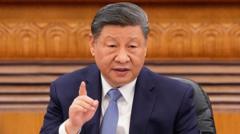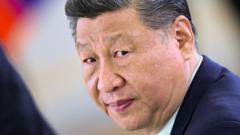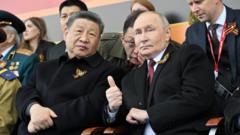In a bold move that is set to escalate the ongoing trade war, President Donald Trump announced sweeping tariffs impacting nearly all of America’s trading partners, with a particular focus on China. During a recent address, Trump asserted his admiration for President Xi Jinping, while accusing China of exploiting trade relations. He claimed the new tariffs would impose a "discounted reciprocal tariff" of 34% on Chinese goods, in response to the high 67% tariffs China allegedly places on American exports.
Tariffs Target China: Trump’s Trade Policy Escalates

Tariffs Target China: Trump’s Trade Policy Escalates
President Trump's latest tariffs on Asian nations are igniting tensions with China, spurring discussions on counteractions.
China swiftly condemned the U.S.'s actions, labeling them "unilateral bullying" and vowing to implement "resolute countermeasures" to protect its rights amid the trade conflict. The Chinese Commerce Ministry criticized the U.S. for oversimplifying the trade situation into a tit-for-tat dynamic. This latest tariff enforcement adds to a 20% tariff already levied on Chinese imports, with numbers projected to surge to 54% in the coming days, excluding certain product categories like steel and automobiles.
Experts indicate that Trump’s tariffs will not only affect China but also South East Asian countries as he targets them with significant levies between 46% to 49% to disrupt what he perceives as China's supply chain advantages. Regions such as Vietnam, Laos, and Cambodia, which historically have garnered Chinese investment, will likely face substantial economic repercussions as supply chains realign following increased U.S. tariffs.
U.S. companies operating in these nations, including major brands like Apple and Nike, may confront tough operational decisions as tariff implications intensify. As the trade landscape shifts, experts predict China may need to adopt a forceful approach in retaliation, potentially leading to strained business conditions for American firms within its borders.
The trade dynamics are further complicated by the necessity for Beijing to forge alliances with fellow Asian economies encountering similar tariff challenges. Recent discussions between China, South Korea, and Japan hint at potential cooperation to navigate the growing protectionist measures. Ultimately, both powers may feel the strain as they move toward possible negotiations to settle the escalating trade conflicts, though analysts expect tensions to worsen before a resolution emerges.
Experts indicate that Trump’s tariffs will not only affect China but also South East Asian countries as he targets them with significant levies between 46% to 49% to disrupt what he perceives as China's supply chain advantages. Regions such as Vietnam, Laos, and Cambodia, which historically have garnered Chinese investment, will likely face substantial economic repercussions as supply chains realign following increased U.S. tariffs.
U.S. companies operating in these nations, including major brands like Apple and Nike, may confront tough operational decisions as tariff implications intensify. As the trade landscape shifts, experts predict China may need to adopt a forceful approach in retaliation, potentially leading to strained business conditions for American firms within its borders.
The trade dynamics are further complicated by the necessity for Beijing to forge alliances with fellow Asian economies encountering similar tariff challenges. Recent discussions between China, South Korea, and Japan hint at potential cooperation to navigate the growing protectionist measures. Ultimately, both powers may feel the strain as they move toward possible negotiations to settle the escalating trade conflicts, though analysts expect tensions to worsen before a resolution emerges.





















